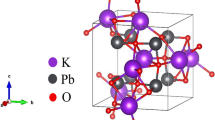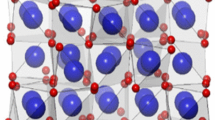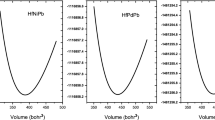Abstract
The structural, electronic, optical, and vibrational properties of B3N3H6 have been calculated by means of the first-principles density functional theory (DFT) calculations within the generalized gradient approximation (GGA) and the local density approximation (LDA). The calculated structural parameters of B3N3H6 are in good agreement with experimental data. The obtained band structure of B3N3H6 shows that it has an indirect band gap with 5.007 eV, indicating that it presents insulation characteristic. The total and partial density of states (DOS) of B3N3H6 are given, which tell us the states of the orbital occupation. With the band structure and density of states, we have analyzed the optical properties including the complex dielectric function, refractive index, absorption, conductivity, loss function, and reflectivity. By the contrast, it is found that optical anisotropy is observed in the (001) direction and (100) direction. Moreover, the vibrational properties have been obtained and analyzed, showing that B3N3H6 is dynamically stable due to that there is no imaginary frequency. The frequencies associating with the vibrations are given, which show that B3N3H6 has a low mechanical modulus and thermal conductivity.
Similar content being viewed by others
Avoid common mistakes on your manuscript.
Introduction
Borazine (B3N3H6), which is generally introduced in textbooks as “inorganic benzene” under aspects of the isoelectronic relationship [1], is an ideal precursor for boron nitride materials because it only contains elements of boron, nitrogen, and hydrogen [2]. It has been used as the precursor for preparation of both boron nitride ceramic matrix composites by precursor infiltration pyrolysis (PIP) and boron nitride coatings by chemical vapor deposition (CVD) [3]. Borazine was originally discovered by the thermal decomposition of the diammoniate of diborane [4]. Both experimental [5, 6] and theoretical [7, 8] works have been performed widely. The thermal decomposition of B3N3H6 in unsaturated vapor has been studied [9], showing that the gaseous B3N3H6 was decomposed on the reaction vessel surface along with the formation of volatile intermediates. The nature of chemical bond [10], ring current strengths [11], and anion-π interactions [12] of B3N3H6 were investigated, indicating its wide applications such as active molecule for electrodes [13], reactant for boron nitride nanowalls [14], low-dimensional spin filters [15, 16]. etc.
Kalemos [10] compared the nature of the chemical bond in B3N3H6, B3O3H3, B2N2C2H6, and related species by considering the excited states of the constituent fragments, which told us that these molecules isoelectronic to benzene were formed due to that BH, CH, NH binded together in their excited states. Rabanal-León et al. [11] investigated the ring current strengths of B3N3X6 (X = H, F, Cl, Br, I, At) by using the magnetically induced current density method, which were used to evaluate the corresponding contributions to aromaticity. Bauzá et al. [12] studied the rings of N6, B3O3H3, B3N3H6, B3N3, and B3S3H3 with the anion-π interactions, which were important to crystal packing and three-dimensional structure. Sen [13] used B3N3H6 as active molecule to investigate the role of asymmetric magnetic electrodes. Merenkov et al. [14] synthesized hexagonal boron nitride nanowalls from B3N3H6 and NH3 gas mixture.
However, there are few studies in the literatures about physical properties of B3N3H6. For example, the optical and vibrational properties associated with the material’s structure are important to the military and civilian applications [17, 18], which have not been reported systematically. The optical properties of the material are critical to the application of laser guidance, optical information processing, telecommunications, infrared countermeasures, radar detection, etc. [19,20,21]. The vibrational properties are linked with the chemical reaction process, molecular bonding strength, Raman spectra, etc. [22,23,24], which are very important to understand the explosion process of energetic materials. Therefore, our purpose is to calculate the electronic structure, optical, and vibrational properties of B3N3H6 by using the first-principles density functional theory.
Computational details
The first-principles calculation with the Cambridge Sequential Total Energy Package (CASTEP) is employed in this paper [25]. The LDA of Ceperley-Alder-Perdew-Zunger (CAPZ) functional as well as GGA of Perdew-Burke-Ernzerhof (PBE) functional are applied as the exchange–correlation functional [26,27,28,29]. In order to consider the van der Waals interactions in B3N3H6 crystal, the DFT-TS [30] and DFT-D2 [31] methods are used. The pseudopotential is an effective potential constructed to replace the ionic core states, that is, the valence electrons are described by pseudo-wave functions [26,27,28,29]. For B3N3H6, the ionic cores are represented by ultrasoft pseudopotential. For B atom, the configuration is 1s22s22p1, where the 2s2 and 2p1 electrons are treated as valence electrons; for N atom, the configuration is 1s22s22p3, where the 2s2 and 2p3 electrons are treated as valence electrons; for H atom, the configuration is 1s1, where the 1s1 electron is treated as valence electron. The energy cutoff of 500 eV is applied in plane-wave basis. The Brillouin-zone integration is performed with 3 × 3 × 1 meshes using the Monkhorst–Pack method [32] for structure optimization. The values of the convergence thresholds for total energy, maximum force, maximum stress, and maximum displacement are 5.0 × 10−6 eV/atom, 0.01 eV/Å, 0.02 GPa, and 5.0 × 10−4 Å.
Results and discussion
Structural properties
The space group of tetragonal structure B3N3H6 is P43212. The crystal mode of B3N3H6 is shown in Fig. 1 after structural optimization, and it is an equilibrium crystal structure of Borazine. The optimized structural parameters of B3N3H6 are given in Table 1 as well as experimental data [1]. It can be seen that the values based on the GGA PBE-TS functional are in good agreement with the experimental results, indicating that this functional can well describe the crystal structure of Borazine. Hence, the physical properties of Borazine are solved by the GGA PBE-TS in the following work.
Electronic properties
The calculated band structure of B3N3H6 within the GGA PBE-TS is shown in Fig. 2. From the band structure, it is shown that B3N3H6 has an indirect band gap because the top of valence band is found at G point, while the bottom of conduction band is found at A point. The band gap is calculated to be 5.007 eV, so we can know that B3N3H6 is an insulator. The calculated band gap value is smaller than the experimental value of 6.5 eV [33]. The discrepancy is due to the well-known underestimation of DFT calculations. In order to solve this discrepancy, we use the B3LYP hybrid functional to recalculate the band structure. The calculated bandgap is 6.711 eV which is close to experimental value.
In the band structure, the valence bands are roughly divided into three regions: − 16.0 eV to − 14.0 eV (lower), − 7.5 eV to 6.0 eV (middle), and − 4.5 eV to 0 eV (higher). Figure 3 shows the total and the partial density of states (DOS) of B3N3H6. With the states between − 16 eV and − 12.5 eV, there is the interaction of N 2 s, B 2p and H 1 s. The states between – 8 eV and – 5 eV are predominantly composed of N 2p, B 2 s and all hydrogen’s 1 s. The valence bands basically arise from interaction of N 2p, B 2p and H 1 s states in the Fermi level.
Optical properties
The optical properties such as the complex dielectric function, complex refractive index, complex conductivity function, reflectivity, loss function, and absorption coefficient are important, which can be obtained from the complex dielectric function [34]:
In this section, we present our results of optical properties of B3N3H6 at the equilibrium lattice constants in Figs. 4–9, up to an energy of 35 eV. We resolve the optical properties into two independent components: the polarization direction (001) component and the polarization direction (100) component. The calculated real part and imaginary part of complex dielectric function of B3N3H6 are shown in Fig. 4. From this figure, the real part of complex dielectric function is ε1 (001) = 2.209 and ε1 (100) = 2.298. There is a peak (ω (001) = 7.735 eV, ω (100) = 7.577 eV) from 4.5 eV to 9 eV for imaginary part, which is attributed to transition from the valence bands to conduction bands (t2g). There is a peak (ω (001) = 13.225 eV, ω (100) = 12.863 eV) for the calculated imaginary part, which is due to transition from the valence bands to conduction bands (eg). The complex refractive index of B3N3H6 is shown in Fig. 5. As shown in Fig. 5, we find that the static refractive index is n (001) (0) = 1.486 and n (100) (0) = 1.516. The refractive index reaches a peak at energy of 6.979 eV in (001) component, while it reaches a peak at energy of 6.806 eV in (100) component. Figures 6, 7, 8 and 9 show the absorption coefficient α(ω), complex conductivity function σ(ω), energy-loss function L(ω), and optical reflectivity R(ω). In each figure, as we can see, the optical anisotropy corresponds to the space group of B3N3H6.
Vibrational properties
As shown in Fig. 10, there are 144 vibrations including 3 acoustic branches and 141 optical branches. The phonon spectra with no imaginary frequency reveal that B3N3H6 is dynamically stable. There is no significant splitting, which indicates that the B3N3H6 has no ability to change the strength of light as an optical device.
As shown in Fig. 10, the frequencies around 3450 cm−1 are referred to the vibrations of B-H and N–H, which are parallel to plane (111) , (111) , (111) and (111), including anti-symmetry and symmetry vibrations. It indicates that the B-H and N–H have a most dynamic strength. The frequencies around 2550 cm−1 are B-N anti-symmetric and symmetric vibrations, which are also parallel to above four planes. According to the calculated results, the vibrations of the frequencies above 896 cm−1 are parallel to four planes. The vibration of phonon is parallel to four planes at high frequencies; it shows that the crystal has a better dynamic stable when the optical radiation along those planes. Below 890 cm−1, the vibrations begin to be perpendicular and parallel to four planes as well as group vibration. It corresponds to a weak covalent bond strength, so the crystal has a low mechanical modulus and thermal conductivity. In a word, these vibrations can be used to present conformational changes and bonding and to reflect the initiation mechanism of energetic materials [24].
Conclusions
We have investigated the structural, electronic, optical, and vibrational properties of B3N3H6. We find that the accurate equilibrium volume of B3N3H6 from DFT calculations can be obtained by the TS correction to treat the van der Waals interactions. From the calculated band structure and density of states, we conclude that B3N3H6 is an insulator with an indirect band gap of 5.007 eV. The obtained optical properties show an optical anisotropy in (100) and (001) due to its tetragonal structure. These peaks associated with the transitions from the occupied to unoccupied states in the imaginary part of dielectric function are given. Moreover, the vibrational properties of B3N3H6 have been computed and these vibrations are discussed, indicating that B3N3H6 shows weak covalent bond strength.
Availability of data and materials
The datasets supporting the results of this work are included within the article; the other datasets generated during the current study are available from the corresponding author on reasonable request.
Code availability
Not applicable.
References
Boese R, Maulitz AH, Stellberg P (1994) Chem Ber 127:1887
Lei MK, Ma TC (1996) J Inorg Mater 11:329
Li JS, Zhang CR, Li B (2011) Bulletin of the Chinese Ceramic Society 30:567
Wideman T, Sneddon LG (1995) Inorg Chem 34:1002
Chiavarino B, Crestoni ME, Marzio AD, Fornarini S, Rosi M (1999) J Am Chem Soc 121:11204
Islas R, Chamorro E, Robles J, Heine T, Santos JC, Merino G (2007) Struct Chem 18:833
Peyerimhoff SD, Buenker RJ (1970) Theoret Chim Acta 19:1
Kiran B, Phukan AK, Jemmis ED (2001) Inorg Chem 40:3615
Zavgorodnii AS, Timoshkin AYu (2018) Russian J General Chem 88:2476
Kalemos A (2018) Int J Quantum Chem. 118:e25650
Rabanal-León WA, Tiznado W, Alvarez-Thon L (2019) Int J Quantum Chem 119:e25859
Bauzá A, Quiñonero D, Deyà PM, Frontera A (2012) Chem Phys Lett 530:145
Sen S (2017) Chem Phys 491:126
Merenkov IS, Kosinova ML, Maximovskii EA (2017) Nanotechnology 28:185602
Zhang CX, Guo H, Yang Z, Luo YH (2012) Acta Phys. Sin. 61:193601
Shao P, Ding LP, Luo DB, Lu C (2020) Molecular Phys. 118:e1667542
Mammeri F, Bourhis EL, Rozes L, Sanchez C (2005) J Mater Chem 15:3787
Qin H, Zeng W, Liu FS, Gan YD, Tang B, Zhu SH, Liu QJ (2021) J Energ Mater 39:125
Wang Y, Luo MJ, Zhao P, Che XL, Cao YZ, Huang FQ (2020) CrystEngComm 22:3526
Jia N, Xiong XX, Wang SP, Yu TT, Han B, Qiao J, Li CN, Tao XT (2018) CrystEngComm 20:7802
Zhang X, Zhao HL, Gao S, Zeng QF (2021) J Rare Earths 39:453
Wu XW, Liu ZC, Ji GF, Zhu WH (2019) J Molecular Graphics Modelling 90:144
Huang W, He ZY, Zhao BJ, Zhu SF, Chen BJ (2019) J Alloys Compounds 796:138
Su Y, Fan JY, Zheng ZY, Zhao JJ (2018) Comput Mater Sci 153:392
Clark SJ, Segall MD, Pickard CJ, Hasnip PJ, Probert MIJ, Refson K, Payne MC (2005) Z Kristallogr 220:567
Ceperley DM, Alder BJ (1980) Phys Rev Lett 45:566
Perdew JP, Zunger A (1981) Phys Rev B 23:5048
Perdew JP, Burke K, Ernzerhof M (1996) Phys Rev Lett 77:3865
Perdew JP, Chevary JA, Vosko SH, Jackson KA, Pederson MR, Singh DJ, Fiolhais C (1992) Phys Rev B 46:6671
Tkatchenko A, Scheffler M (2009) Phys Rev Lett 102:073005
Grimme S (2006) J Comput Chem 27:1787
Monkhorst HJ, Pack JD (1976) Phys Rev B 13:5188
Zunger A (1974) J Phys C: Solid State Phys 7:76
Gao J, Zeng W, Tang B, Zhong M, Liu QJ (2021) Mater Sci Semicond Process 121:105447
Author information
Authors and Affiliations
Contributions
Yun-Dan Gan: writing — original draft, investigation, methodology, data curation. Han Qin: methodology, conceptualization. Fu-Sheng Liu: theoretical analysis, formal analysis. Zheng-Tang Liu: visualization, software. Cheng-Lu Jiang: formal analysis, validation, writing — review and editing. Qi-Jun Liu: conceptualization; writing, review and editing; supervision.
Corresponding authors
Ethics declarations
Conflict of interest
The authors declare no competing interests.
Additional information
Publisher's note
Springer Nature remains neutral with regard to jurisdictional claims in published maps and institutional affiliations.
Rights and permissions
About this article
Cite this article
Gan, YD., Qin, H., Liu, FS. et al. Electronic, optical, and vibrational properties of B3N3H6 from first-principles calculations. J Mol Model 27, 241 (2021). https://doi.org/10.1007/s00894-021-04862-6
Received:
Accepted:
Published:
DOI: https://doi.org/10.1007/s00894-021-04862-6














